I am trying to make a grouped bar chart in which the bars are colored based on one variable(binary/ e.g. Group 1 and group2), and then the transparency of the bars are based on another value(continuous/ e.g. p-value), but I want the transparency to be specific to each groups color, and I want the gradient to and legend to be continuous.
I have been able to get close using the color, group, and fill options in geom_bar. You will see that I can get the over all gradient to work and the outlines of the bars are colored correctly. But I would like the fill to be the colors of the outlines and retain the transparency. I also tried using scale_alpha, which maps the transparencies correctly, but doesn't produce a continuous legend.
Here is a small data set like the one I am working with
## data set
d <- data.frame(ID = rep(c(123, 456), 2),
description = rep(c("cancer", "infection"), 2),
variable = c("G2", "G2", "G1", "G1"),
value = c(1.535709, 1.582127, 4.093683, 4.658328),
pvals = c(9.806872e-12, 1.160182e-09, 3.179635e-05, 1.132216e-04))
Here is the ggplot code
ggplot(d, aes(x=reorder(description, -pvals), y=value)) +
geom_bar(stat="identity", aes(col=variable, group=variable, fill=pvals), position="dodge") +
ylim(0, max(d$value) + 0.6) + xlab("") +
coord_flip() +
scale_fill_brewer(palette = "Set1",
name="",
breaks=c("G1", "G2"),
labels=c("Group 1", "Group 2")) +
scale_fill_continuous(trans = 'log10') # I am using log10 transformation because I have many small p-values and this makes the shading look better
Here is attempt 2 where the fill works but the legend does not.
ggplot(d, aes(x=reorder(description, -pvals), y=value)) +
geom_bar(stat="identity", aes(fill=variable, alpha = pvals), position="dodge") +
ylim(0, max(d$value) + 0.6) + xlab("") +
coord_flip() +
scale_fill_brewer(palette = "Set1",
name="",
breaks=c("G1", "G2"),
labels=c("G1", "G2")) +
scale_alpha(trans = "log10")

